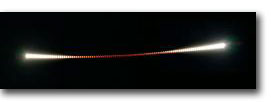Total Lunar Eclipse
xantox, 27 February 2007 in GalleryOther Languages:
Timelapse photo of the total lunar eclipse of October 27, 2004.1 Celestial bodies orbiting around a star cast shadows, which may partially or totally obscure other bodies aligned behind them, “eclipsing” the star from their viewpoint (from Greek ekleipein, “failing to appear”).
Given their short duration, eclipses are amongst the phenomena where cosmic scale dynamics may be perceived most dramatically. In the picture, the moon’s curved path is primarily due to Earth’s rotation, and to a small extent to the lunar motion in its elliptical orbit around the Earth. During the totality stage the Moon appears red, because Earth’s atmosphere scatters sunlight and only red wavelengths are refracted into the shadow. An observer on the moon would see a bright ring of red light, coming from all simultaneous Earth’s sunrises and sunsets.2
A total lunar eclipse will happen Saturday, March 3, 2007, and will be visible from Europe, Africa, Western Asia and Eastern America.
- Picture © Forrest J. Egan, Digital Astro [↩]
- Eclipse seen from the moon, Surveyor 3 mission, 24 April 1967 (artificial color) © NASA [↩]
You can leave a reply, or trackback from your own site.


28 February 2007, 6:33 pm
How rare in the universe are the sort of solar eclipses we see from Earth?
As I understand it, the size of the moon and its distance relative to earth, and the earth to the Sun result in a masking of the sun that leaves the solar corona visible.
The moon seems “unusually” large with respect to the Earth, but it’s size and position result in being “just the right size” to create the appearance that the moon and sun are the same size, so when the moon transits the sun it just obscures the center, but leaves the corona.
Isn’t that likely to be “unusual” in the universe?
I’ve sometimes wondered what sort of “unique” identifying features there are that will distinguish us from other life from other places - DNA? Saturn’s rings (probably not)? Corona-leaving solar eclipses?
What icons might we use to identify ourselves? We’re the ones from the planet with coronal solar eclipses with DNA-based life forms?
Assuming it’s to our advantage to be readily identifiable, that is…
3 March 2007, 6:18 pm
Hello Ed. To observe this kind of aural eclipse, the star should be bigger than the eclipsing body by the same ratio as the latter is closer to the observer. In the solar system this happens only on Earth, and there is no data about exoplanets moons. You should also consider that since orbits may change with time, there may be times when aural eclipses happen and times when they not happen, for the same bodies. For example, millions of years ago when the Moon was closer to the Earth, there were no such eclipses on Earth, too.
For your second question, it depends on what you want to describe, either human beings in general, that is an abstract description, or a particular person’s lifetime. In the first case, lunar eclipses are not meaningful if, even when they not happen, your description keeps the same. In the second case they are meaningful as for any other event, as your future lifetime, dreams and actions may be considerably different if you decide to observe todays eclipse or not.